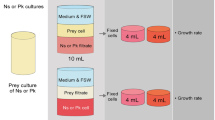Abstract
The aim of this work has been to analyze the effects of a bioemulsificant exopolysaccharide (EPS2003) on the abundance and vitality of natural marine microbial population. Harbor seawater microcosms, supplemented with bioemulsificant EPS2003 (at different concentrations), were monitored over 20 days. The microbial community dynamic was analyzed by measurement of bacterial density (total and cultivable count) and vitality (live/dead count and total RNA amount). The results obtained show that addition of bioemulsificant (also at different concentrations), as sole carbon source, supported growth of the indigenous bacterial populations and revealed that this substance is optimal for use in the participations of recovery of environment polluted from oil. In comparison, an analysis with commercial dispersant was also carried out.






Similar content being viewed by others
References
Banat, I. M. (1995). Biosurfactants production and possible use in microbial enhanced oil recovery and oil pollution remediation: a review. Biosource Technology, 51(1), 1–12.
Banat, I. M., Makkar, R. S., & Cameotra, S. S. (2000). Potential commercial applications of microbial surfactants. Applied Microbiology and Biotechnology, 53(5), 495–508.
Cappello, S., Crisari, A., Denaro, R., Crescenzi, F., Porcelli, F., & Yakimov, M. M. (2011). Biodegradation of a bioemulsificant exopolysaccharide (EPS2003) by marine bacteria. Water, Air, and Soil Pollution, 214, 645–652.
Cappello, S., Caruso, G., Zampino, D., Monticelli, L. S., Maimone, G., Denaro, R., Tripodo, B., Troussellier, M., Yakimov, M. M., & Giuliano, L. (2007). Microbial community dynamics during assays of harbour oil spill bioremediation: a microscale simulation study. Journal of Applied Microbiology, 102(1), 184–194.
Collins, G. G., & Symons, R. H. (1992). Extraction of nuclear DNA from grape vine leaves by a modified procedure. Plant Molecular Biology Reporter, 10, 233–235.
Crescenzi, F., Camilli, M., Fascetti, E., Porcelli, F., Prosperi, G., & Sacceddu, P. (2003). Microbial degradation of biosurfactant dispersed oil. #499, International Oil Spill Conference.
Desai, J. D., & Banat, M. I. (1997). Microbial production of surfactants and their commercial potential. Microbiology and Molecular Biology Reviews, 61(1), 47–64.
Doyle, J. J., & Doyle, J. L. (1990). Isolation of plant DNA from fresh tissue. Focus, 12, 13–15.
Lebaron, P., Servais, P., Troussellier, M., Courties, C., Muyzer, G., Bernard, L., Shafer, H., Pukall, R., Stackebrandt, E., Guindulain, T., & Vives-Rego, J. (2001). Microbial community dynamics in Mediterranean nutrient-enriched seawater mesocosms: change in abundances, activity and composition. FEMS Microbiology Ecology, 34, 255–266.
Lindstrom, J. E. & Braddock, J. F. (2002). Biodegradation of petroleum hydrocarbons at low temperature in the presence of the dispersant Corexit 9500. Marine Pollution Bulletin,739-747.
Makkar, R. S., & Rockne, K. J. (2003). Comparison of synthetic surfactants and biosurfactants in enhancing biodegrdation of polycyclic aromatic hydrocarbons. Environmental Toxicology and Chemistry, 22(10), 2280–2292.
Porter, K. G., & Feig, Y. S. (1980). The use of DAPI for identifying and counting aquatic microflora. Limnology and Oceanography, 25, 943–948.
Ron, E. Z., & Rosenberg, E. (2001). Natural roles of biosurfactants. Environmental Microbiology, 3(4), 229–236.
Sar, N., & Rosenberg, E. (1983). Emulsan production by Acinetobacter calcoaceticus strains. Current Microbiology, 9, 309–314.
Schafer, H., Bernad, L., Courties, C., Lebaron, P., Servais, P., Pukall, R., Stackebrandt, E., Troussellier, M., Guindulain, T., Vives-Rego, J., & Muyzer, G. (2001). Microbial community dynamics in Mediterranean nutrient-enriched seawater mesocosms: changes in the genetic diversity of bacterial populations. FEMS Microbiology Ecology, 34, 243–253.
Shoam, Y., Rosenberg, M., & Rosenberg, E. (1983a). Bacterial degradation of emulsan. Applied and Environmental Microbiology, 46(3), 573–579.
Shoam, Y., Rosenberg, M., & Rosenberg, E. (1983b). Enzymatic depolymerization of emulsan. Journal of Bacteriology, 156(1), 161–167.
Sivaraman, C., Ganguly, A., Nikolausz, M., & Mutnuri, S. (2011). Isolation of hydrocarbonoclastic bacteria from bilge oil contaminated water. International Journal of Environmental Science and Technology, 8(3), 461–470.
Supaphol, S., Panichsakpatana, S., Trakulnaleamsai, S., Tungkananuruk, N., Roughjanajirapa, P., & O’Donell, A. G. (2006). The selection of mixed microbial inocula in environmental biotechnology: example using petroleum contaminated tropical soils. Journal of Microbiological Methods, 65, 432–441.
Tjessen, K., Pedersen, D., & Aaberg, A. (1984). On the environmental fate of a dispersed Ekofisk crude oil in sea-immersed plastic columns. Water Research, 9, 1129–1136.
Yakimov, M. M., Denaro, R., Genovese, M., Cappello, S., D’Auria, G., Chernikova, T. N., Timmis, K. T., Golyshin, P. N., & Giuliano, L. (2005). Natural microbial diversity in superficial sediments of Milazzo Harbour (Sicily) and community successions during microcosm enrichment with various hydrocarbons. Environmental Microbiology, 7(9), 1426–1441.
Acknowledgments
We are indebted to Renata Denaro for excellent technical assistance. Thank you very much to Monique Mancuso for aid in live/dead count. This work was supported by grants from the Italian National Operative Programme (Project PON S.A.B.I.E.).
Author information
Authors and Affiliations
Corresponding author
Rights and permissions
About this article
Cite this article
Cappello, S., Crisari, A., Hassanshahian, M. et al. Effect of a Bioemulsificant Exopolysaccharide (EPS2003) on Abundance and Vitality of Marine Bacteria. Water Air Soil Pollut 223, 3903–3909 (2012). https://doi.org/10.1007/s11270-012-1159-8
Received:
Accepted:
Published:
Issue Date:
DOI: https://doi.org/10.1007/s11270-012-1159-8




